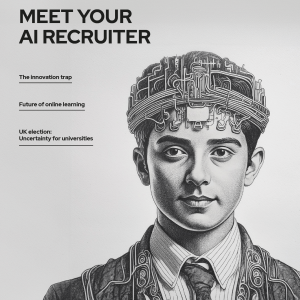

Source:
Debating the merits of human recruiters vs. AI chatbots
By Chloë Lane
Less than two years have passed since ChatGPT was first released to the public. For many, OpenAI’s chatbot was their first real introduction to AI technology.
Now, in 2024, AI is being used regularly in many different industries and is continuing to grow. The global market for AI in education is expected to reach $6 billion by 2025.
In higher education specifically, one of the ways it is used is in helping students decide where to study. Over a third of students surveyed in a recent QS report said that Generative AI has influenced their choice of course, university and career.
When considering a study destination, applicants understandably have plenty of questions for students and faculty at their institution of interest. However, these questions can often go unanswered for a long time if asked outside of standard helpdesk hours. This is where AI chatbots come in.
AI alone is not enough to attract the best candidates
At the Open Institute of Technology (OPIT), an online institution which specialises in tech degrees, students undoubtedly prefer to interact with real tutors and appreciate the opportunity to meet professors and classmates face-to-face, even in a virtual setting. But when it comes to student recruitment, Greta Maiocchi, Head of Marketing and Admissions, can certainly see the appeal of an AI chatbot.
“AI chatbots can provide immediate answers at any time of day or night, which can be very convenient for students with busy or irregular schedules,” she says. “They can efficiently handle routine inquiries and provide instant information, but they do not replace the depth that human interactions offer.”
She raises the point that while AI chatbots can offer quick responses, they are limited by the data used to train them and might not fully address specific or nuanced queries. Besides, the empathy and personalised support provided by human interactions are crucial and cannot be easily replaced.
“Human touch fosters a sense of belonging and support that is essential for a fulfilling educational experience,” she admits.
A combination of AI chatbots and human interactions would therefore be the most effective approach for student recruitment, Maiocchi believes. This approach, she says, will maximise efficiency while maintaining the personal touch that students value.
Transparency is a key factor to consider, adds Maiocchi. Students should always be informed when they are interacting with an AI chatbot, ensuring that they know when to expect automated responses and when to seek more personalised assistance.
“Recruitment offices can restructure to maximise efficiency by utilising AI for routine tasks but should always ensure that human staff are available to offer the necessary depth and personalised touch that prospective students often seek,” she advises.
“Ensuring a human presence, especially in the later stages of the recruitment process, is crucial for building trust and fostering a positive experience.”
Read the full article below:
Have questions?
Visit our FAQ page or get in touch with us!
Write us at +39 335 576 0263
Get in touch at hello@opit.com
Talk to one of our Study Advisors
We are international
We can speak in:




